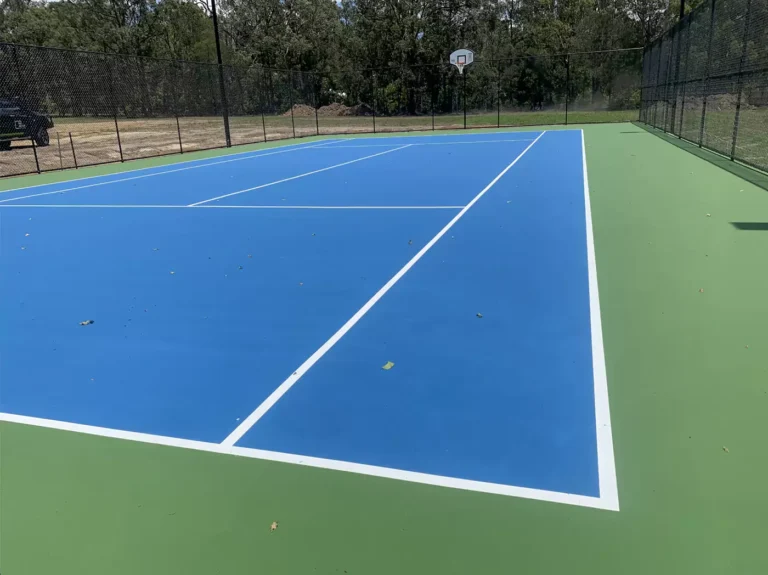Premium Pickleball Court Construction for Every Degree of Play
Premium Pickleball Court Construction for Every Degree of Play
Blog Article
Lasting Practices in Pickleball Court Construction You Must Know
As the appeal of pickleball continues to climb, so too does the requirement for sustainable methods in court construction. This method not only addresses environmental concerns yet additionally boosts the longevity and performance of the courts. From selecting green products to applying efficient drain and energy-saving lighting solutions, there are numerous techniques to think about. Yet, the impact of these methods extends much past the court itself. Recognizing just how each element adds to an extra sustainable future invites even more expedition right into the intricate balance in between entertainment growth and environmental stewardship.
Selecting Eco-Friendly Materials
Picking eco-friendly products is a critical action in the construction of sustainable pickleball courts. The option of lasting materials not just reduces ecological effect yet also boosts the longevity and performance of the court. Key materials consist of reused rubber for the surface, which offers superb sturdiness and shock absorption while diverting waste from land fills.
Additionally, utilizing locally sourced materials minimizes transportation emissions and sustains regional economic climates. Pickleball court construction. Utilizing indigenous woods for secure fencing and seats can provide a sustainable visual while ensuring durability versus the aspects.
Incorporating absorptive materials for court foundations can additionally add to sustainability by enabling natural water drain and lowering runoff. These selections not just secure neighborhood ecosystems but also promote much healthier play environments.
Efficient Drainage Solutions
While the selection of green products is vital, implementing effective water drainage options is equally essential for keeping sustainable pickleball courts. Appropriate drainage not just safeguards the court surface from water damage yet also minimizes erosion and runoff, advertising ecological stability.
Reliable drain systems can include permeable paving, which permits water to infiltrate the ground as opposed to merging on the surface. This lowers the probability of standing water, which can result in mold and various other upkeep issues. Furthermore, including purposefully placed drain networks and swales can route excess water far from the court location, making certain a dry playing surface and avoiding soil erosion.
Utilizing native greenery in the landscaping around the courts can better enhance drainage by absorbing excess water and reducing runoff. These plants require much less irrigation and promote biodiversity, straightening with lasting practices.
Furthermore, it is essential to frequently maintain the water drainage system to ensure its lasting efficiency. This includes clearing particles and monitoring for clogs. By prioritizing effective water drainage remedies, pickleball court producers can substantially add to the sustainability and long life of the center, ultimately profiting both gamers and the environment.
Energy-Efficient Illumination Options
As the need for pickleball proceeds to grow, integrating energy-efficient illumination options right into court design has ended up being significantly important for sustainability. Conventional lights systems typically consume extreme power, adding to greater functional prices and environmental impact. As a result, taking on modern, energy-efficient technologies is vital for both brand-new building and constructions and renovations.
LED (Light Emitting Diode) illumination Click Here stands apart as a leading choice due to its durability and power cost savings (Pickleball court construction). Compared to standard lighting, LEDs make use of approximately 75% less power and can last as much as 25 times much longer, dramatically decreasing upkeep expenses. Furthermore, the directional nature of LED illumination decreases light air pollution, guaranteeing that lighting is concentrated on the court instead of bordering locations.

Lasting Surface Alternatives
Checking out lasting surface area alternatives for pickleball courts has actually obtained traction among gamers and contractors alike. The focus on environment-friendly materials not only straightens with the expanding ecological understanding but also boosts the efficiency and durability of the courts.
One preferred choice is making use of recycled rubber, which can be sourced from utilized tires. This material supplies exceptional shock absorption, lowering the risk of injuries for gamers while advertising sustainability. Additionally, modular floor tiles made from recycled plastics offer an additional viable alternative. These floor tiles are simple to change and mount, and their flexibility permits numerous court setups.
Natural grass courts are additionally emerging as a sustainable selection, promoting biodiversity and minimizing the heat island impact. However, they need normal maintenance and water, which may not line up with all sustainability objectives.

Water Preservation Techniques

One more efficient technique entails the installment of rainwater harvesting systems. These systems accumulate and keep rainwater for usage in keeping court surface areas and landscaping. This strategy not just conserves safe and clean water however also reduces dependence on community resources.
Additionally, employing drought-resistant landscape design around the courts is essential. Indigenous plants need much less water and are much better adapted to local climate problems, hence decreasing overall water intake. In addition, using efficient watering systems, such as drip watering, ensures that water is provided straight to plant origins, lessening dissipation and waste.
Final Thought
Incorporating lasting practices in pickleball court building and construction significantly adds to environmental conservation and resource effectiveness. By prioritizing these techniques, the building of pickleball courts can line up with more comprehensive environmental objectives while advertising durability and capability within communities.
As the popularity of pickleball proceeds to climb, so as well does the need for lasting practices in court building.Picking green products is a crucial step in the building and construction of sustainable pickleball courts. By prioritizing energy-efficient lights choices, pickleball court fabricators can contribute to a more sustainable future while fulfilling the demands of players and stakeholders alike.Including lasting surface alternatives not only enhances the performance of pickleball courts but likewise paves the method for executing efficient water preservation strategies.Integrating sustainable techniques in pickleball court building and construction considerably adds to ecological preservation and resource performance.
Report this page